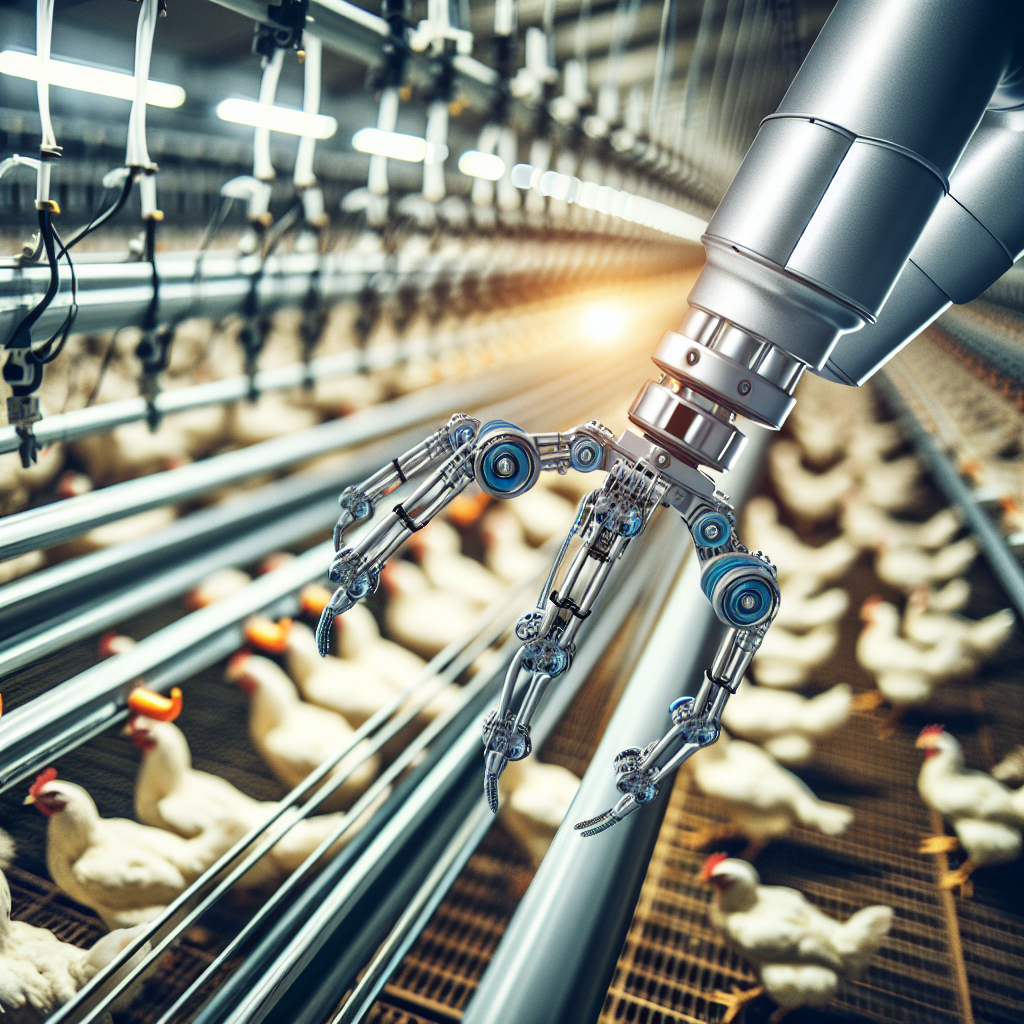Are you looking to optimize egg production and tracking? Wondering how technology can help? In today’s fast-paced world, tech solutions have revolutionized various industries, and the egg production industry is no exception. With the advancements in digital monitoring systems, data analysis, and automation, technology can provide valuable insights and streamline processes, ensuring efficient egg production and tracking. From smart sensors to cloud-based data management, these tech solutions offer unprecedented opportunities to maximize productivity, improve quality control, and enhance overall performance in the egg production industry.
Importance of Egg Production Optimization and Tracking
Egg production optimization and tracking play a crucial role in the poultry industry. By implementing effective tech solutions, you can streamline operations, increase efficiency, and ensure the highest quality eggs. Not only does this benefit the poultry farm, but it also meets market demands, improves traceability, and maintains consumer trust. Let’s delve into the reasons why optimizing egg production and tracking is of utmost importance.
Efficiency of Egg Production
Efficiency is key when it comes to egg production. By utilizing tech solutions, you can automate various processes, minimizing manual labor and reducing the time and effort required for tasks such as data collection, monitoring, and analysis. This, in turn, leads to increased productivity and greater output of eggs. With optimized egg production, you can meet the growing demand for eggs more effectively.
Traceability and Quality Control
In today’s consumer-driven market, traceability and quality control are paramount. Tech solutions enable you to track each egg from the moment it is laid until it reaches the consumer’s hands. This ensures transparency in the supply chain and allows for quick identification and resolution of any quality issues. With accurate traceability, you can maintain the highest standards of product quality and safety, building trust with your customers.
Meeting Market Demands
The market demand for eggs continues to rise, as more and more people recognize the nutritional benefits of eggs and their versatile use in various culinary delights. By optimizing egg production and tracking, you can ensure a steady and consistent supply of eggs to meet market demands. Tech solutions enable you to anticipate market trends, analyze production data, and make informed decisions to stay ahead of the competition.
Challenges in Egg Production and Tracking
Despite the importance of egg production optimization and tracking, there are several challenges that poultry farmers face. These challenges can be addressed effectively with the help of tech solutions.
Lack of Accurate Data
One of the key challenges in egg production is the lack of accurate and real-time data. Traditional manual methods of data collection often result in errors and inconsistencies, leading to improper decision-making. Tech solutions provide automated data collection systems that accurately capture and analyze data, providing valuable insights on various aspects of egg production, such as egg count, weight, temperature, humidity, and environmental conditions.
Labor-Intensive Processes
Egg production involves labor-intensive processes, such as manual egg counting, sorting, and weighing. These processes are not only time-consuming but also prone to errors. Tech solutions offer automated systems that streamline these processes, reducing the need for manual labor and ensuring greater accuracy and efficiency. By automating repetitive tasks, you can free up your workforce to focus on more critical aspects of egg production.
Risk of Human Error
Human error is a common concern in any industry, and the poultry sector is no exception. From data entry mistakes to misidentification of eggs, human error can lead to significant repercussions in egg production and tracking. Tech solutions mitigate these risks by utilizing advanced technologies such as artificial intelligence and machine learning. These technologies can detect patterns, make accurate predictions, and alert operators to potential issues before they escalate, minimizing the impact of human error.
Tech Solutions for Egg Production Optimization
To optimize egg production, various tech solutions can be implemented. These solutions leverage automation, real-time monitoring, and artificial intelligence to streamline operations and improve overall efficiency.
Automated Data Collection
Automated data collection is a game-changer in the poultry industry. By integrating sensors and smart devices into the production environment, you can collect accurate and real-time data on egg count, weight, temperature, humidity, and environmental conditions. This data can then be analyzed to identify trends, optimize production processes, and make informed decisions regarding feed, nutrition, and environmental management.
Real-time Monitoring
Real-time monitoring allows you to keep a close eye on the poultry environment, ensuring optimal conditions for egg production. Smart cameras equipped with computer vision technology can monitor poultry behavior, identifying any abnormalities or signs of distress. Automated alert systems can immediately notify farm managers or operators of any issues, enabling timely intervention. Furthermore, remote access and control allow you to monitor and make adjustments to the production environment from anywhere, ensuring constant oversight and intervention if required.
Artificial Intelligence and Machine Learning
Artificial intelligence and machine learning algorithms are revolutionizing the poultry industry. By analyzing large sets of data, these technologies can provide valuable insights and predictive analytics for egg production optimization. They can help identify patterns and correlations between various factors, enabling you to optimize feed composition, nutritional requirements, and environmental conditions. Additionally, AI-powered systems can detect early signs of diseases, allowing for prompt intervention and prevention.
Automated Data Collection
Efficient egg production optimization begins with accurate and real-time data collection. Tech solutions offer various automated data collection methods that eliminate the need for manual labor and improve data accuracy.
Sensors for Egg Count and Weight
Implementing sensors for egg count and weight can greatly enhance the efficiency of egg production. These sensors can be integrated into the egg collection process, automatically recording the number of eggs collected and their respective weights. This eliminates the need for manual counting and weighing, reducing the chances of errors and saving valuable time.
Temperature and Humidity Monitoring
Maintaining optimal temperature and humidity levels is crucial for egg production. Tech solutions enable the installation of sensors and monitoring systems that continuously measure and record temperature and humidity levels in the poultry sheds. Data from these sensors can be analyzed to ensure that the environment is conducive to egg production and make any necessary adjustments to maintain optimal conditions.
Environment and Feed Analysis
Tech solutions also allow for the analysis of environmental factors and feed composition to optimize egg production. Sensors can be deployed to monitor air quality, lighting conditions, and feed consumption. By analyzing this data, you can identify potential issues, such as poor ventilation or inadequate feed formulation, and take corrective measures to improve egg production efficiency.
Real-time Monitoring
Real-time monitoring plays a vital role in ensuring the well-being of the flock and optimizing egg production. Tech solutions offer a range of tools and systems that enable real-time monitoring across various aspects of egg production.
Smart Cameras for Poultry Behavior
Smart cameras equipped with intelligent computer vision technology can monitor poultry behavior round the clock. These cameras can identify abnormalities or signs of distress, such as aggression, abnormal movement, or unusual flock behavior. Real-time analysis of poultry behavior allows for prompt intervention in case of any issues, providing early detection and prevention of problems that may impact egg production.
Automated Alert Systems
To ensure timely intervention, tech solutions provide automated alert systems. These systems can be set up to send notifications to farm managers or operators when specific parameters, such as temperature, humidity, or poultry behavior, deviate from the desired range. These alerts enable immediate action, avoiding any potential negative impacts on egg production.
Remote Access and Control
Tech solutions also offer remote access and control capabilities. Through mobile applications or web interfaces, farm managers can monitor and control various aspects of egg production from anywhere. This feature not only provides constant oversight but also allows for immediate adjustments to environmental conditions, feed dispensing, and other parameters to optimize egg production.
Artificial Intelligence and Machine Learning
Artificial intelligence and machine learning technologies are revolutionizing the poultry industry by providing advanced analytics and predictive capabilities for egg production optimization.
Predictive Analytics for Egg Production
By analyzing historical and real-time data, AI systems can generate predictive analytics for egg production. These advanced algorithms can forecast egg production levels based on various factors, such as environmental conditions, feed composition, and the age of the flock. With accurate predictions, farm managers can make data-driven decisions regarding feed management, vaccination schedules, and flock rotation, maximizing egg production efficiency.
Optimizing Feed and Nutrition
Optimizing feed formulation is essential for maximizing egg production. AI algorithms can analyze vast amounts of data, including nutritional requirements, ingredient availability, and flock performance, to generate optimal feed compositions. By adjusting feed formulations based on real-time data and predictions, you can ensure that the flock receives the required nutrition for optimal egg production.
Early Detection of Diseases
Early detection and prevention of diseases are critical in maintaining flock health and productivity. AI-powered systems can analyze sensor data, such as temperature, humidity, and poultry behavior patterns, to detect early signs of diseases. By identifying abnormalities or deviations from normal patterns, AI algorithms can alert farm managers of potential health issues, allowing for prompt intervention and prevention of disease outbreaks that may harm egg production.
Tech Solutions for Egg Tracking
Efficient egg tracking is essential for ensuring product quality, traceability, and consumer trust. Tech solutions offer various methods to track eggs throughout the supply chain.
Barcode and RFID Tagging
Barcode and RFID tagging systems provide a reliable and efficient way to track individual eggs. Each egg can be assigned a unique identifier, allowing for accurate tracking from the moment it is laid until it reaches the consumer. These systems enable efficient inventory management, batch tracking, and expiry date tracking, ensuring the freshness and quality of eggs throughout the supply chain.
GPS Tracking and Geolocation
Monitoring the movement of eggs during transportation is crucial to maintain their quality and freshness. GPS tracking and geolocation systems can be used to track egg shipments, allowing for real-time monitoring of location, temperature, and humidity. This ensures that eggs are transported and stored under optimal conditions, guaranteeing their freshness upon reaching the consumer.
Blockchain-based Traceability
Blockchain technology provides a transparent and secure platform for traceability in the egg supply chain. By recording each transaction and movement on a blockchain ledger, stakeholders can easily track the origin, processing, and distribution of eggs. This enhances transparency and accountability, prevents fraud, and instills consumer trust and confidence in the eggs they purchase.
Barcode and RFID Tagging
Barcode and RFID tagging systems have revolutionized egg tracking in the poultry industry, offering numerous benefits for both producers and consumers.
Individual Egg Identification
Barcode and RFID tagging allow for individual eggs to be uniquely identified and tracked throughout their journey. Each egg is assigned a unique identifier, which can be scanned or read by RFID readers at various stages of the supply chain. This enables accurate tracking and ensures that each egg can be traced back to its source, providing valuable information about its quality, freshness, and safety.
Efficient Inventory Management
Barcode and RFID tagging systems simplify inventory management processes for poultry farmers and distributors. By scanning or reading the tags, the number of eggs in stock can be accurately recorded, eliminating the need for manual counting and reducing the chances of errors. This streamlines inventory management, ensures proper rotation of stock, and prevents wastage or spoilage of eggs.
Batch and Expiry Date Tracking
Barcode and RFID tags can also be used to track the batch and expiry dates of eggs. This information is essential for managing stock and ensuring that eggs are sold within their optimal shelf life. By scanning or reading the tags, producers and retailers can identify eggs that are nearing their expiry dates and take appropriate actions, such as marking them for immediate sale or removing them from the shelves to maintain product quality and consumer satisfaction.
GPS Tracking and Geolocation
GPS tracking and geolocation systems offer a reliable means of monitoring the movement and location of eggs during transportation, ensuring their freshness and quality.
Monitoring Movement of Eggs
During transportation, it is crucial to monitor the movement of eggs to ensure they are handled properly and not subjected to unfavorable conditions. GPS tracking systems can track the location and movement of egg shipments in real-time. This information can be relayed to producers and distributors, allowing them to have visibility over the transportation process and take immediate action if any deviations or delays occur.
Efficient Logistics and Transportation
GPS tracking and geolocation systems optimize logistics and transportation processes for egg production. By tracking the location and movements of egg shipments, producers and distributors can optimize delivery routes, reduce transportation costs, and ensure timely delivery to the market. This not only improves operational efficiency but also maintains the freshness and quality of eggs, enhancing customer satisfaction.
Ensuring Freshness and Quality
Proper handling and storage are crucial for ensuring the freshness and quality of eggs. GPS tracking systems can monitor temperature and humidity levels during transportation, providing real-time alerts if any deviations occur. This allows producers and distributors to take immediate action, such as adjusting temperature controls or rerouting shipments, to ensure that eggs are transported and stored under optimal conditions, maintaining their freshness and quality.
Blockchain-based Traceability
Blockchain-based traceability is revolutionizing the way eggs are tracked and monitored in the poultry industry, providing transparency, accountability, and consumer confidence.
Transparency and Accountability in the Supply Chain
Implementing blockchain-based traceability ensures transparency and accountability in the egg supply chain. Each transaction and movement of eggs is recorded on a blockchain ledger, which can be accessed by stakeholders, including producers, distributors, and consumers. This transparency enables stakeholders to verify the origin, processing, and distribution of eggs, addressing concerns about food safety, quality, and ethical practices.
Authentication and Fraud Prevention
Blockchain technology provides a secure platform for authenticating eggs and preventing fraud. With unique identifiers recorded on the blockchain, consumers can easily verify the authenticity of eggs by scanning or reading the associated barcode or RFID tag. This prevents the sale of counterfeit or inferior quality eggs, protecting consumer interests and maintaining trust in the integrity of the egg supply chain.
Consumer Trust and Confidence
By implementing blockchain-based traceability, the egg industry can enhance consumer trust and confidence. With access to transparent information about the origin and journey of eggs, consumers can make informed decisions based on their preferences and requirements. They can verify claims about organic, free-range, or ethically sourced eggs, promoting ethical consumption and supporting sustainable practices in the poultry industry.
In conclusion, optimizing egg production and tracking through the implementation of tech solutions offers numerous benefits for the poultry industry. With automated data collection, real-time monitoring, and the use of artificial intelligence and machine learning, egg production can be streamlined, resulting in increased productivity and efficiency. Barcode and RFID tagging, GPS tracking and geolocation, and blockchain-based traceability systems ensure accurate and transparent tracking of eggs throughout the supply chain, enhancing quality control, traceability, and consumer trust. By utilizing these tech solutions, poultry farmers can meet market demands, optimize production processes, and maintain the highest standards of product quality and safety.



